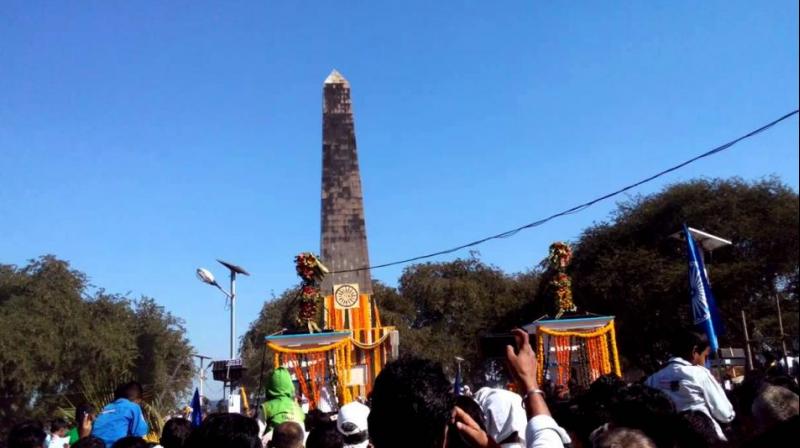Caste factor resurfaces, but has limitations too

Not many are interested in the real historical significance of the Bhima-Koregaon battle where the Mahar contingent of the East India Company forces defeated the Peshwa’s army in 1818. The Peshwas were not a major power at the beginning of the 19th century. Their glory ended with the Third Battle of Panipat in 1761. The memory of Mahar bravery is worth remembering, but it did not change the fortunes of the community in any big way, nor did it alter the condition of the dalits in the rest of the country. It is a matter of doubtful validity whether the success of the Mahars in that battle of two centuries ago would serve as a morale booster for dalits across the country now.
There is, however, the harsh truth that whenever dalits gather in a big way as they did in Bhima-Koregaon on New Year’s Day last week, the other dominant castes feel uneasy and even a little bit frightened. The sight of lakhs of the dispossessed at one place must indeed drive shivers of fear down the spines of the those who believe themselves to be upper castes. The gathering of the poor in Paris at the time of French Revolution in 1789 must have been spine-chilling to the remnants of the French nobility of the day. But the unfortunate truth is that the incandescent moment of dalit strength and pride does not last, and most of them go back to their daily lives of struggle, frustration and some success.
It is interesting in this context to note the observations of Ramdas Athavale of the Republican Party of India and Union minister of state in the Narendra Modi government. He advised the new dalit political star from Gujarat, Jignesh Mevani, to build bridges and not create divisions. What he meant was that confrontation would not help in the present times. It is the advice of a seasoned politician to an upcoming one. Then he made a far more important remark. He said that if so many dalits could gather, it should be possible for Prakash Ambedkar’s faction of the RPI and his own to fight the elections together and decide whether they should support the Congress or the BJP.
The BJP’s political and ideological opponents look to assertions of caste identity to counter the overweening, or what appears to be dominant, hold of the Hindutva party in the country. For the last three years, the Congress, the Communists, the Samajwadi Party, the Bahujan Samaj Party and Lalu Prasad Yadav’s Rashtriya Janata Dal have almost despaired of countering Prime Minister Narendra Modi’s nebulous rhetoric of economic development. They knew that Mr Modi’s BJP could be scoring brownie points on development issues, but the main thrust of the Prime Minister’s party is rightist-oriented Hindutva nationalism. The Patidar agitation in Gujarat prior to the 2017 Assembly elections and the reassertion of Dalit identity in the Bhima-Koregaon gathering near Pune in Maharashtra is sure to warm the hearts of the BJP’s critics and opponents that the so-called Hindutva consensus which seemed to have emerged in the majority community is breaking down under the stress of caste identities intertwined with economic woes.
The BJP leaders seem to have sensed the problem of social unrest expressing itself through the caste voice. Prime Minister Modi, speaking at the BJP office in New Delhi immediately after the narrow victory in the Gujarat Assembly elections, expressed his fear and uneasiness. He said he would not allow Gujarati people to be split along caste lines. It is the echo of what his party senior of the past, Lal Krishna Advani, had said in the face of Mandal challenge posed by Vishwanath Pratap Singh when he announced reservations for the Other Backward Classes (OBCs) in government jobs in 1990, and Mr Advani countered it with the Ram Janmabhoomi agitation, saying it was done to save Hindu society from being splintered along caste lines. Mr Advani did not really succeed in the 1990s though he believed he did. Mr Modi thinks that he is uniting all sections of society on the development plank, though many of his critics would say that what he has in mind is just Hindus, and that he does not care about the religious minorities.
In Gujarat, Madhya Pradesh, Chhattisgarh and Jharkhand, the Rashtriya Swayamsevak Sangh (RSS) had worked assiduously to Hinduise the tribal population across central India, and created a votebank for the BJP. There was also an attempt to win over the OBCs as well. The BJP has benefited hugely from the political consolidation of the Scheduled Tribes (STs) and OBCs. But it was never going to be a stable social-political block. It is showing cracks and the BJP is quite clueless about how to deal with it effectively. The Hindutva rhetoric has run its course, and it does not any more serve as the political talisman that it seemed to be for some years now.
The emerging spokespersons of caste formations like Hardik Patel of the Patidars and Jignesh Mevani of the Dalits or Alpesh Thakore are likely to become mainstream political leaders sooner rather than later, and their voicing of caste interests and concerns, which are real and genuine, may not be sufficient by themselves because protest is a symptom and not a solution to difficult social and economic problems. The anti-BJP cheerleaders should not get tipsy over the emergence of these young voices as they did over Kanhaiya Kumar of Jawaharlal Nehru University some time back. The challenge to the political dominance of the BJP and Mr Modi comes from the people at large and for diverse reasons. The Left liberals would be committing a blunder if they confound popular discontent with the BJP and Mr Modi with politics based on caste identities.

